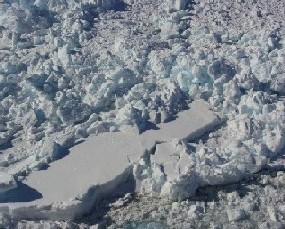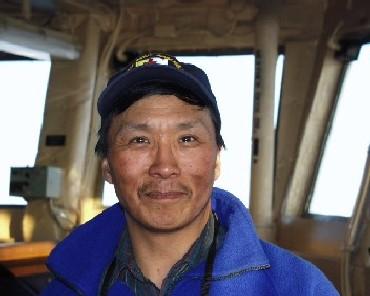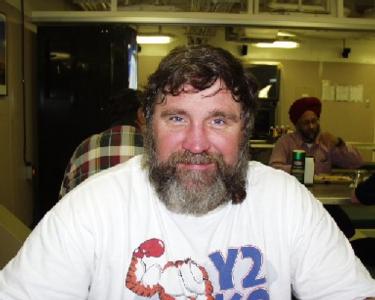
|
1 May, 2000My First Polar Bear DRAFT May 1, 2000 Daily Data (20:30): Lat. 6819.54N Long. 06326.069W Heading 243.211 Air Temp. -12.33C 9.81F True Wind Dir. 33.1 True Wind Speed 6.0 Dear Everyone, Progress has been difficult over the past two days. Yesterday we only made around three miles and most of it was due to the drift of the ice. We are in the midst of what is called a "Rubble Field" (see "Vocabulary of the day"). Home Bay is 75 miles away and we hope to be there by Tuesday night or Wednesday. We have been backing and ramming for the past few days. The ice is increasingly challenging. Yesterday we regularly encountered ice of 1° meters thick total and experienced ridges of 3 to 4 meters high with total thickness of approximately 20 meters. Last night we had about three hours of nautical twilight. The sun is 12 degrees below the horizon. The Healy has been parking a few hours during the night due the difficulty of driving the ship in ice during darkness. The ship remained parked this morning due to zero visibility (fog). The fog began to lift around 9:30 AM. The science teams are anxiously awaiting the work that begins as soon as level ice of 4° feet thickness can be located. Vocabulary of the day: >From Roger Provost, Canadian Ice Service , Ottawa, Canada: Rubble field: This is an area of extremely irregular and malformed sea ice of unusual thickness. It is formed during the winter by the motion of drift ice and ice floes bumping into each other. A weak area in a floe may crack and the floes then push together to form scores of ridges. Inuit language lesson from Stevie Audlakiak: Olokkut (say "oh low co"): Good afternoon. Onokkut (say "oh no co"): Good evening. Yesterday afternoon I found James Qillaq from Clyde River, Baffin Island, one of the Healy's two Inuit guides, at the fore of the bridge scanning the ice. We talked about Polar Bears based upon his personal experiences and knowledge of them. James Qillaq tells me that Polar Bears are travelers that are always in search of food. They will remain for about three to four weeks in one place, just long enough to find food and then travel on. James sees bears mostly in the fall and the spring on the ice floes. After the floes break up, the bears are on land. What do the bears eat? They prefer to eat mostly seal, especially the seal fat. If they are exceptionally hungry, they will eat seal meat. Sometimes Polar Bears will eat fish. Polar Bears have white fur and black skin. The older the bear is, the more yellowish and thinner their hair becomes. As James says, "It's kind of like people." The black skin functions similar to a solar panel providing warmth to the bear. Polar bears have five claws with one being smaller like our thumb. Only four claws show in their tracks. The average male weighs around 400 lbs. and the average female weighs about half that at about 200 lbs. Polar bears breed each year in April and May. At these times females are usually seen along the leads hunting for seals. During the breeding season, males are especially dangerous. After the breeding season, the bears are just searching for food and are not as exceedingly dangerous as they are in the springtime. Cubs are habitually born around October in a snow cave under a cliff (like a glacier) that the mother prepares. She usually returns to the same snow and ice den to have her cubs if she is in the area the following year. She will remain in her cave for about five months with the cubs and will not leave to hunt for food. When she leaves her den with her cubs in the spring, she is extraordinarily hungry. James thinks the gestation period for Polar Bears is around eight to nine months, but is not certain. He says that bears usually have one to three cubs and that they stay with their mother for a number of years. Over the years, mothers can have several cubs with her at one time. Polar bear cubs are amazing small at birth, the size of a puppy. The mother will hold the cub in her paw next to her fur to keep the cub warm and feed it. Cubs are born with very little fur. James says, "You can't really see it. You can feel it with your fingers." What does Polar Bear taste like? "It's good, like beef. We don't eat it raw. It's only little stronger than beef when it's young. Older bear tastes stronger. We boil it. Sometimes cook it in the oven." James explains. I met with Stevie Audlakiak from Broughton Island, our other Inuit guide, after our daily science meeting this morning. We discussed Polar Bears, Stevie's sled dogs, his love for diving under the ice and many details of his culture and daily life. Stevie, like James, shared his knowledge of Polar Bears based upon his personnel experiences. Stevie tells me that Polar Bears travel more in the evening and at night, especially from midnight to morning, in the summertime. They tend to rest during the daytime when it is too warm for them. The bears are awake all winter and travel continuously searching for food. Without sunlight, it is very cold and the bears require more food for the energy they need to survive. In the winter, the bears search for seal holes and wait to catch seals when they come up for air. In April, Stevie says the bears shed their fur for summer and for winter they get a new and heavy coat. He says females can be from ten to eleven feet long and males up to thirteen feet long. Although the bears cannot run as fast as his dogs, Stevie says they can run from roughly 9 to 10 knots. They tend to travel alone except when they have cubs. Stevie explains that Polar Bears generally have two cubs and if there is a third one, then it is typically much smaller than the other two cubs that are commonly of the same size. Once the bears leave their snow dens March with their cubs, they are especially hungry. They follow the leads in search of seal pups to eat. The cubs remain with their mother for three or four years until they begin to mate. Words of experience from Stevie: "There could be bear anywhere, anytime. Could come without warning. Come very quiet. Dogs can tell when bear is nearby. Can tell faster than the Inuit. Dogs can smell bear distance away." Just as I was beginning to write this journal entry, Jeff Andrews of the National Ice Center in Washington, D.C. called to me from the stairwell (I keep my stateroom door open when I work) saying, "Sandra, there's a bear! Come to the bridge." I grabbed my cameras and flew up the three decks. Awesome, gorgeous, thrilling only begin to describe my experience. It was too far away to photograph nicely, but what an exquisite performance. He even stood up and waved to me. Just joking! But he did stand up. Best regards, Sandra For photos and more: ../tea_kolbfrontpage.html For further information: ../ http://www.uscg.mil./pacarea/healy
Contact the TEA in the field at . If you cannot connect through your browser, copy the TEA's e-mail address in the "To:" line of your favorite e-mail package. |







